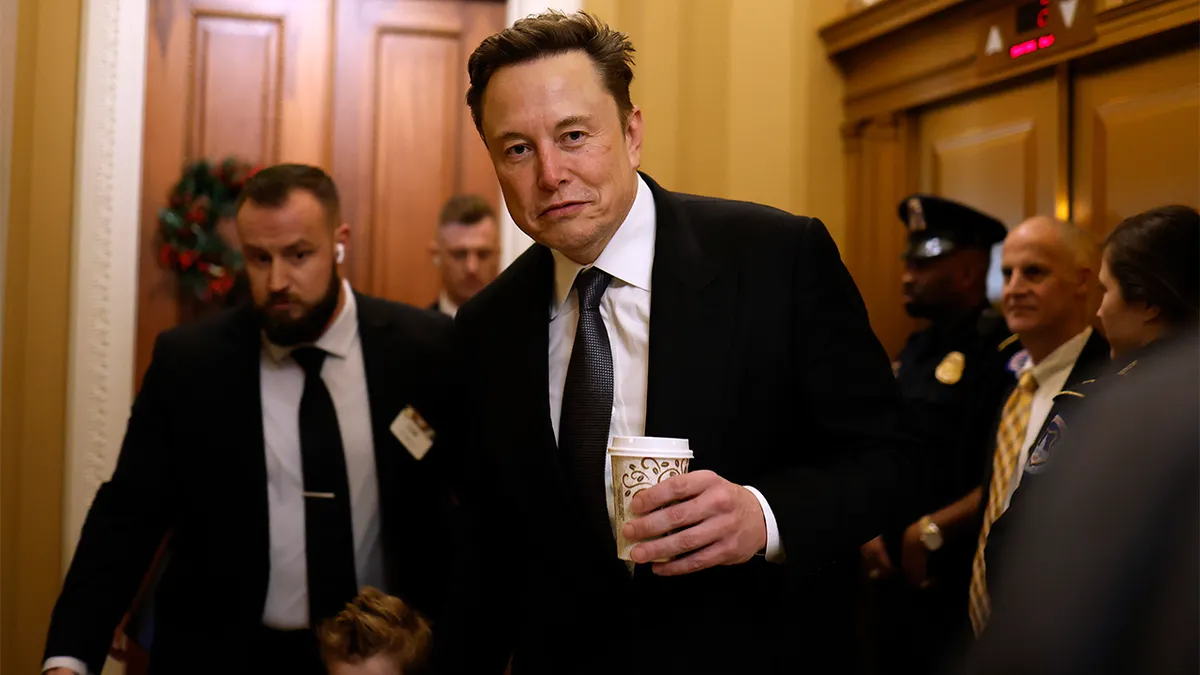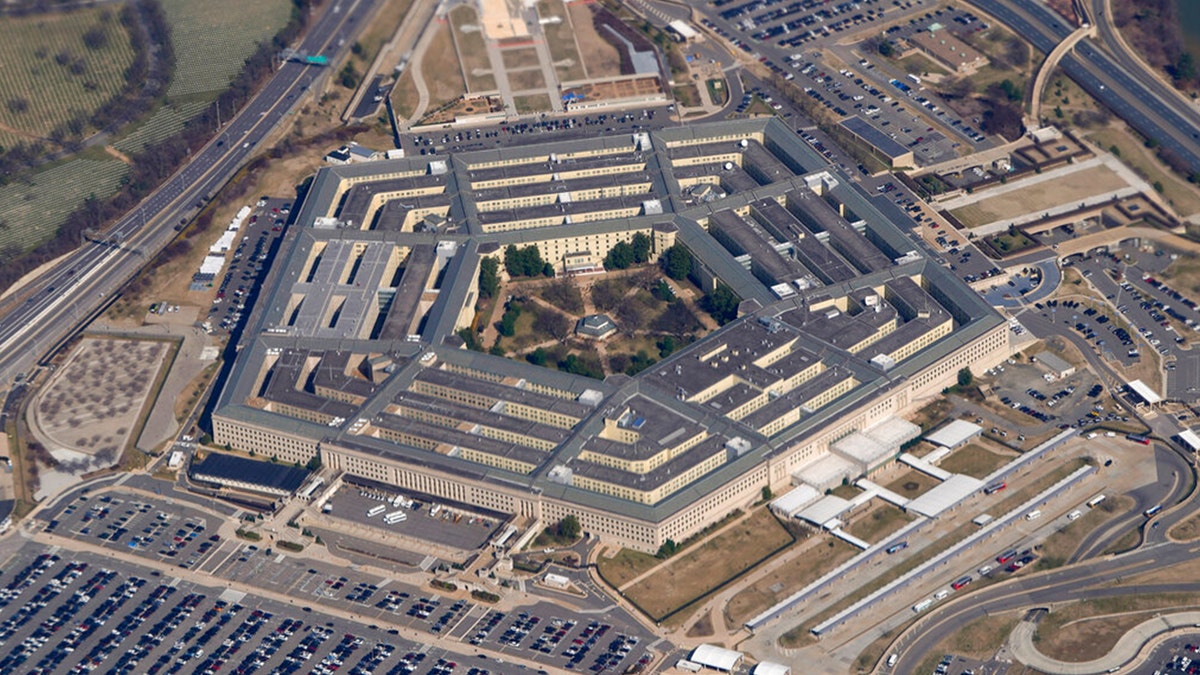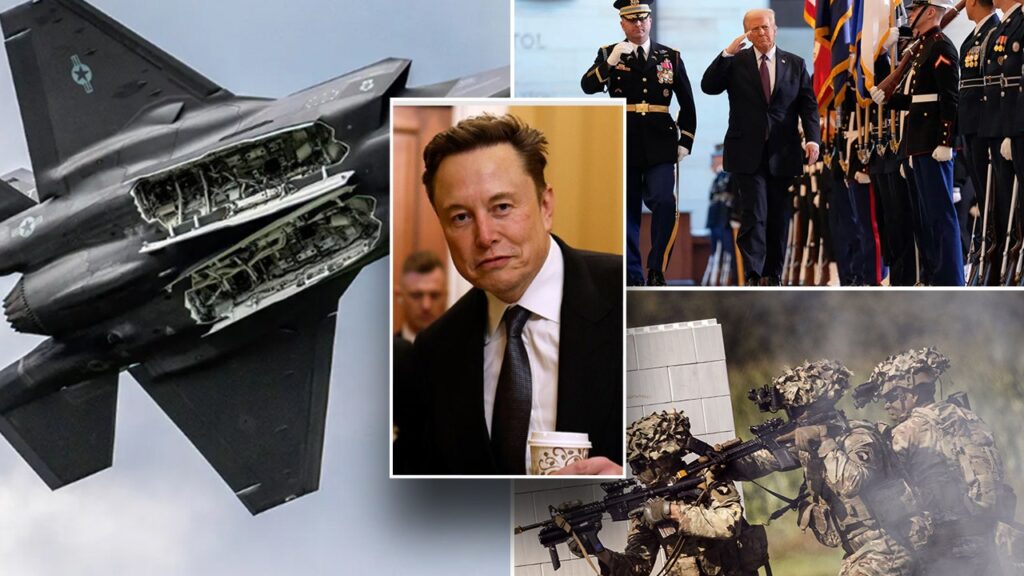President Donald Trump‘s team of zealous cost-cutters under Elon Musk will soon set their sights on the U.S.’s largest discretionary budget.
With an annual budget of $850 billion, the Pentagon has long been plagued by accusations of waste and inefficiency in its defense programs and recently failed its seventh straight audit.
“We’re going to find billions, hundreds of millions of dollars of fraud and abuse,” Trump predicted in an interview with Fox News’ Bret Baier on Sunday.
Congress appropriates the Department of Defense (DOD) budget each year in great detail, and urging lawmakers to trim costs may be where Republicans publicly break with Musk and his burn-it-all-down style.
Here is a look at where the Department of Government Efficiency team could set their sights.
MUSK’S NEXT TARGET? TRUMP SAYS DOGE WILL LOOK AT DEPARTMENT OF EDUCATION, PENTAGON FUNDING

President Donald Trump’s team of cost-cutting gurus under Elon Musk, pictured here, will soon set their sights on the U.S.’s largest discretionary budget. (Anna Moneymaker/Getty Images)
Personnel and contracting
The inclination of Musk and his team seems to be to cull federal employees, but cost-cutting advocates argue that outsourcing work to contractors could have the opposite effect.
Typically, around half the Pentagon’s budget goes to contractors, corporations that have a profit motive unlike the government itself. The government relies on contractors for software support, training, weapons and to act as paramilitary forces in foreign missions.
“A major driver of Pentagon waste is actually service contracting for what are really core government functions and administrative capacities, like simple things [such] as IT support,” said Julia Gledhill, a researcher at the Stimson Center’s National Security Reform program.
“It might run contrary to their larger project based on efforts to cut the civilian workforce, but there are a lot of areas to cut Pentagon waste by actually building up government capacity to do basic administrative functions rather than outsourcing them at a very high cost.”
HEGSETH WELCOMES IN ELON MUSK’S DOGE FOR ‘LONG OVERDUE’ DOD SPENDING OVERHAUL

The Pentagon is seen from Air Force One as it flies over Washington, D.C., on March 2, 2022. (AP Photo/Patrick Semansky, File)
In 2015, the Defense Business Board, at the request of DOD leaders, found that the Pentagon could save $125 billion over five years by renegotiating service contracts, streamlining the bureaucracy through attrition and early retirements, and consolidating IT processes.
The report found the Pentagon was paying an eye-watering 1,014,000 contractors to fill back-office jobs far away from the front lines. The DOD currently only lists around 1.3 million active duty troops.
However, the plan was never widely implemented, and Pentagon leaders took steps to “bury” it for fear of budget cuts, according to a Washington Post report.
In October 2024, a two-year audit by the Defense Department Inspector General found Boeing overcharged the Air Force by 8,000% for soap dispensers that the service branch paid $149,072 over market price for. Of a selected 46 spare parts that were scrutinized by the audit, the report found the Air Force overpaid about $1 million for 12 of them for its C-17 transport planes.
That followed a 2018 congressional inquiry that revealed the Air Force was spending $1,300 for each reheatable coffee cup on its KC-10 aircraft – and then replacing them instead of repairing them when their handles broke. Sen. Chuck Grassley, R-Iowa, found the Air Force spent $32,000 replacing 25 cups.
Weapons programs: F-35s and land-based ICBMs
Musk has suggested that he will look to eliminate the F-35 stealth fighter jet program, long dogged by cost overruns, glitches and delays. In posts on X, he called it the “the worst military value for money in history,” and the jet itself “an expensive & complex jack of all trades, master of none” and added that “manned fighter jets are obsolete in the age of drones anyway.”
However, doing away with the F-35 has run into opposition in Congress every time it has been suggested.
A recent report put out by Taxpayers for Common Sense, Quincy Institute and Stimson called for retiring the F-35 jets and eliminating a ballistic missile program.

Elon Musk has suggested that he will look to eliminate the F-35 stealth fighter jet program, long dogged by cost overruns, glitches and delays. (Andrej Tarfila/SOPA Images/LightRocket via Getty Images)
Halting the F-35 fighter jet program, dogged by cost overruns, glitches and delays, as some have advocated for, would trim $12 billion per year, according to the joint report.
However, Congress would need to get on board with defunding the F-35 in its yearly defense bill, and Lockheed Martin produces the plane’s parts in many states across the country, where lawmakers have constituents with jobs at risk.
“Defunding weapons that are overpriced, underperforming, and out of step with current missions, like the F-35 combat aircraft and the Sentinel intercontinental ballistic missile, would allow us to invest more in real priorities while also tackling the nation’s tremendous debt,” said Gabe Murphy of Taxpayers for Common Sense.
TRUMP DOD CREATES TASK FORCE TO ABOLISH DEI OFFICES THAT ‘PROMOTE SYSTEMIC RACISM’
“The ICBM no longer necessarily the most accurate, you know, weapon we have in our nuclear arsenal,” added Gledhill.
“We have our sea and air legs of the nuclear triad that are just as accurate and, you know, not as vulnerable as our ICBMs are because, you know, ICBMs are in the ground, we know where they are. It’s public knowledge.”
The report found that eliminating the Sentinel ICBM program would save $3.7 billion per year.
Base realignment
The Stimson report found that “targeted closures and realignments” of U.S. military bases could save another $3-5 billion per year.
“Even if say I accept all the missions we have now in the world, you could probably cut some overseas bases without even really rethinking strategy,” said Ben Friedman, policy director at Defense Priorities.
“If you accept that we’re trying to manage the Middle East through US military troop presence or at least the ability to deploy troops and say, okay, we could do with fewer bases.”
The Trump team is reportedly considering shutting down its presence in Syria, where 2,000 troops are currently stationed.
In the 1980s, under President Ronald Reagan, the government took up an effort known as Base Realignment and Closure (BRAC), a post-Cold War process to coordinate the end of force postures that are no longer needed. Five rounds of BRAC shut down 350 installations at a savings of $12 billion, but the last BRAC process ended in 2011.

Targeted base closures could save taxpayers between $3-5 billion. (Photo by Hedil Amir/Anadolu Agency via Getty Images)
Defense research
Some of the Pentagon’s $143.2 billion budget for research may also come under scrutiny.
Lawmakers last year demanded to know how an AI researcher in China acquired $30 million in U.S. grants. In 2021, Song-Chun Zhu was the lead investigator on two projects totaling $1.2 million from DOD grants seeking to develop “high-level robot autonomy” that is “important for DoD tasks,” and “cognitive robot platforms” for “intelligence and surveillance systems.”
Additionally, the Defense Department inspector general found last summer that $46.7 million in defense funds from 2014 to 2023 had gone to EcoHealth Alliance, the nonprofit that funded gain-of-function research at the Wuhan Institute of Virology, a lab many suspect was the origin of the COVID-19 pandemic.

Sen. Joni Ernst, R-Iowa., a veteran, is chairwoman of the Senate DOGE Caucus and has called out wasteful spending at the Pentagon. (Reuters)
Use-it-or-lose-it spending
Under a use-it-or-lose-it policy, in the last month of the fiscal year, federal agencies work to spend all that is left in their federal budgets, worried that Congress will appropriate them a smaller amount next year if not. The Pentagon is no exception.
In September 2024, the DOD spent more than it had in any other month since 2008, with a hefty taxpayer price tag for fine dining.
It spent $6.1 million on lobster tails, $16.6 million on rib-eye steaks, 6.4 million on salmon and $407,000 on Alaskan king crab, as highlighted in an X thread by Sen. Joni Ernst, R-Iowa.
That same month, DOD spent $211.7 million on new furniture, including $36,000 on foot rests.
CLICK HERE TO GET THE FOX NEWS APP
Political headwinds
Cost-cutting initiatives will face opposition from a Congress that has never been keen to take a scalpel to the nation’s defenses.
“If history is any kind of precedent, I do think that this is where you’ll start to see at least a real sort of tension arise,” said Diana Shaw, former State Department Inspector General. “There are a lot of vested interests, and not just economic.”
“There are folks with philosophical interests in the entire defense infrastructure and the military. And so, this is an area that has been well protected historically. And so I do think this now will be an interesting test case to see whether there will be, even within the Republican Party now, some pushback to the sort of aggressive cutting and picking apart that we’ve seen happen at other agencies that have historically been sort of less favored by members of the Republican Party.”







